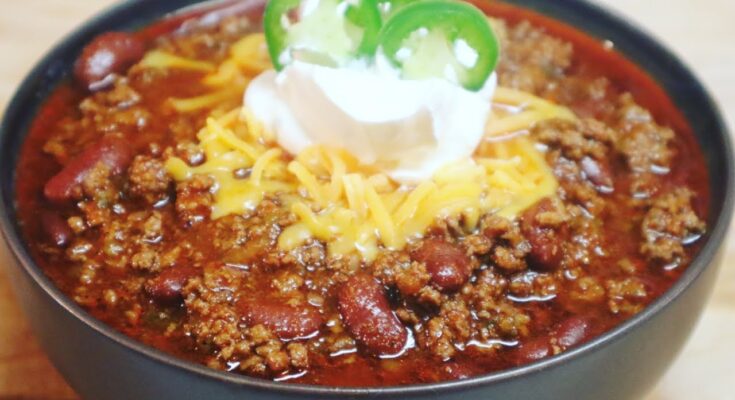Chile Recipe: Chile dishes are a staple in many households, offering bold flavors, warmth, and just the right amount of spice to satisfy any palate.
Whether it’s a cold winter day or a social gathering, a well-made bowl of chile can bring everyone to the table. But what makes a perfect chile?
This guide will take you through every step, ingredient, and tip you need to master a delicious chile recipe right in your kitchen.
What is Chile?
Chile, also known as “chili” in some regions, is a hearty, flavorful dish made with a blend of meat, chile peppers, seasonings, and sometimes beans. It’s a versatile dish that can be mild or fiery hot depending on your taste preference. Originating from the fusion of Mexican and Texan cuisines, chile recipes have since evolved, with countless variations available today. From the rich, tomato-based “chile con carne” to creamy green chile stews, there’s something for everyone.
Essential Ingredients for Making Chile
To make a classic chile, you’ll need some essential ingredients that bring out the depth and complexity of the dish. Here are some staples:
- Ground meat: Often beef, turkey, or pork, though you can go meat-free with plant-based alternatives.
- Chiles: Fresh or dried, such as jalapeños, ancho, or chipotle peppers.
- Vegetables: Onions, garlic, and tomatoes provide a strong flavor base.
- Seasonings: Chili powder, cumin, oregano, paprika, and salt.
- Beans (optional): Kidney beans, black beans, or pinto beans can be added for texture.
It’s important to decide between fresh and canned ingredients based on your preferences. Fresh tomatoes and chiles offer vibrant flavors, while canned ingredients can save time.
Types of Chiles Commonly Used in Recipes
Not all chiles are created equal. Understanding the types of chiles can help you control the heat and flavor profile of your dish.
- Jalapeños: Medium heat, often used fresh or roasted.
- Ancho (dried poblano): Mild with a slightly sweet, smoky taste.
- Chipotle: Smoked and dried jalapeños that provide a rich, smoky depth.
- Habanero: Extremely spicy, recommended in small amounts for those who love heat.
- New Mexico or Hatch Chiles: Mild to medium heat, often used in green chile recipes.
Equipment You’ll Need
While you don’t need a lot of fancy tools to make chile, having the right equipment will make the cooking process easier and more efficient.
- Large pot or Dutch oven: Ideal for slow cooking and simmering the ingredients.
- Cutting board and sharp knife: For chopping vegetables and chiles.
- Wooden spoon: Perfect for stirring without scratching your pot.
- Blender or food processor: Useful if you’re making your own chile paste or puréeing ingredients.
- Ladle: For serving the finished dish.
Preparing the Ingredients
Before you start cooking, it’s essential to prepare your ingredients correctly. Handling chile peppers can be tricky due to their heat level. Follow these tips:
- Wear gloves: Chiles contain capsaicin, which can irritate your skin and eyes.
- Remove seeds and membranes: These parts contain most of the heat, so adjust based on your spice preference.
- Chop vegetables uniformly: This ensures even cooking and better flavor distribution.
Taking the time to prep everything in advance will make the actual cooking process much smoother.
Step-by-Step Guide to Making Classic Chile
Now it’s time to dive into the recipe! Follow these detailed steps to create a mouthwatering chile dish that’s sure to impress.
Step 1: Sautéing the Aromatics
Start by heating a bit of oil in your large pot. Add chopped onions, garlic, and any fresh peppers you’re using. Cook over medium heat until the onions become translucent and fragrant. This builds the foundation of flavor for your chile.
Step 2: Cooking the Meat
If your recipe includes meat, add it to the pot next. Break it apart with your spoon and cook until it’s browned and no longer pink. Browning the meat adds richness and depth to the dish.
Step 3: Adding Chiles and Seasonings
Now it’s time to bring the heat! Add your chopped or dried chiles, followed by seasonings like chili powder, cumin, and paprika. Stir well to coat everything evenly. This step allows the spices to “bloom,” enhancing their flavor.
Step 4: Simmering the Mixture
Pour in your liquid ingredients, such as broth, crushed tomatoes, or beer, and bring the pot to a boil. Reduce the heat to low and let the chile simmer for at least 30 minutes to an hour. The longer it simmers, the more the flavors will meld together. Be sure to stir occasionally to prevent sticking.
Step 5: Adding the Final Touches
Taste your chile and adjust the seasoning as needed. If you’re using beans, add them during the last 15-20 minutes of cooking. You can also stir in a bit of lime juice or fresh cilantro to brighten up the flavors.
Tips for Perfecting Your Chile Recipe
- Don’t rush the simmering process: Great chile takes time for the flavors to develop.
- Balance the flavors: If your chile is too spicy, add a little sugar or dairy (like sour cream) to tone it down.
- Experiment with ingredients: Feel free to try different types of peppers and seasonings to make the recipe your own.
Customizing the Recipe
One of the best things about making chile is that it’s highly customizable. Whether you like it mild, extra spicy, or packed with veggies, you can tweak the recipe to fit your preferences. Here are some ways to make the dish your own:
- For more heat: Add finely chopped habanero or extra jalapeños. Alternatively, sprinkle in some cayenne pepper or hot sauce.
- To tone down the heat: Remove the seeds and membranes from the chiles or substitute them with mild peppers like Anaheim or bell peppers.
- Add more texture: Incorporate ingredients like corn, bell peppers, or zucchini for a hearty, vegetable-rich version.
- Change the protein: Swap ground beef for turkey, chicken, or plant-based alternatives for a lighter option.
Playing around with different ingredients can result in a unique dish every time you make it!
Serving Suggestions
A bowl of chile is satisfying on its own, but adding some thoughtful sides and garnishes can elevate the meal even more. Here are a few serving ideas:
- Toppings: Shredded cheese, sour cream, chopped cilantro, diced onions, and avocado slices all add flavor and contrast.
- Sides: Serve your chile with warm cornbread, tortilla chips, rice, or crusty bread to soak up all that delicious sauce.
- Creative presentation: Ladle your chile into bowls and sprinkle on garnishes right before serving. You can also serve it in bread bowls for an extra fun touch.
Whether you’re hosting a party or enjoying a quiet dinner at home, these serving ideas will make your chile a hit.
Common Variations of Chile Recipes
Over the years, chile has evolved into many different variations, each with its own distinct flavors and ingredients. Here are some popular types to try:
Chile con Carne
This classic version features a rich tomato base, ground or cubed beef, and a blend of spices. Beans are often left out of this dish, depending on regional preferences. It’s hearty, flavorful, and perfect for meat lovers.
Vegetarian or Vegan Chile
Plant-based versions of chile replace the meat with ingredients like mushrooms, lentils, or a mix of beans and vegetables. Seasonings remain the same, making it just as flavorful and satisfying.
Green Chile Stew
Made with green chile peppers (like Hatch or poblano), this stew is often paired with pork, chicken, or turkey. It has a milder, tangy flavor compared to traditional red chile recipes and is a staple in Southwestern cuisine.
How to Store and Reheat Chile
If you have leftovers (lucky you!), chile can be stored and reheated easily without losing its flavor.
- Storage: Allow the chile to cool completely before transferring it to an airtight container. Refrigerate for up to 4-5 days.
- Freezing: Chile freezes well. Divide it into portions and store in freezer-safe containers for up to three months.
- Reheating: Reheat in a pot over medium heat, stirring occasionally. Add a splash of water or broth if it’s too thick. Microwaving is also an option, though stovetop reheating is recommended for better flavor.
Proper storage and reheating ensure that your chile tastes just as good the second (or third) time around!
Health Benefits of Eating Chile
Did you know that chile isn’t just delicious but also nutritious? Here are some health benefits you can enjoy:
- Rich in vitamins: Chiles are high in vitamin C, which boosts your immune system.
- Metabolism boost: Capsaicin, the compound that gives chiles their heat, may help speed up metabolism and aid in weight management.
- Heart health: The fiber, protein, and antioxidants in chile ingredients can support cardiovascular health.
- Pain relief: Capsaicin has been used in topical treatments to help relieve pain by reducing inflammation.
So the next time you dig into a spicy bowl of chile, remember—you’re doing your body a favor!
FAQs about Chile Recipe
1. What ingredients are needed for a basic chile recipe?
A traditional chile recipe typically includes ground meat (beef, pork, or turkey), onions, garlic, diced tomatoes, kidney or black beans, and a mix of spices like cumin, chili powder, and paprika. You can also add green chiles or bell peppers for more flavor.
2. How long does it take to cook chile?
The cooking time for chile can vary. A stovetop version might take about 30 to 45 minutes to simmer, while a slow cooker recipe could take 4 to 8 hours on low setting, allowing flavors to meld together beautifully.
3. Can chile be made vegetarian or vegan?
Absolutely! For a vegetarian or vegan version, simply substitute the meat with a plant-based alternative like tofu, tempeh, or extra beans. Use vegetable broth instead of beef or chicken broth and ensure all other ingredients are meat-free.
4. Is chile gluten-free?
Chile can be gluten-free, but it’s important to check the labels on processed ingredients like broth and canned goods. Spices and fresh produce are naturally gluten-free, making them safe for those with gluten sensitivities.
5. How can I make my chile spicier or milder?
Adjust the heat level by varying the amount of chili powder, adding more for a spicier dish or reducing it for a milder version. Fresh jalapeños, cayenne pepper, or hot sauce can also enhance the spice.
6. What are the best toppings for chile?
Popular toppings include shredded cheese, sour cream, chopped green onions, cilantro, diced avocado, or tortilla chips for added crunch and flavor.
7. Can chile be frozen for later use?
Yes, chile freezes well. Cool it completely, then store it in airtight containers. It can be kept frozen for up to 3 months. Thaw in the refrigerator overnight and reheat on the stove or in a microwave.
8. What’s the difference between chile and chili?
While “chile” refers to the pepper itself, “chili” is the stew-like dish that includes meat, beans, spices, and sometimes chile peppers. Both spellings can be used interchangeably in recipes.
Conclusion
Chile is a flavorful, comforting dish that’s easy to make and endlessly adaptable. With the right ingredients, preparation, and a little patience, you can create a meal that warms both the body and soul. Whether you prefer it mild or extra spicy, with meat or plant-based, chile is a crowd-pleasing dish worth mastering.
So grab your pot, gather your ingredients, and get cooking—you’re just a few steps away from chile perfection!



